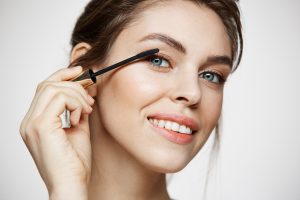Eyeshadows, mascara, eye-liner, but also creams and masks: there are so many products that come into contact with our eyes on a daily basis. The list of raw materials from which all these cosmetics are manufactured is long, from preservatives to antioxidants, from fragrances to colourants. However, some of these ingredients pose a health risk to consumers and, among the potential sites of reaction to these substances, the eye and periorbital region are considered particularly sensitive due to their location and anatomy. The application of eye make-up can lead to discomfort, allergic reactions and inflammation. These disorders can occur because certain substances affect the quality of the lipid layer of the ocular surface and can be key factors in the onset or exacerbation of dry eye syndrome (DED).
The dry eye syndrome, characterised by symptoms of dryness and irritation of the ocular surface due to alterations in the quality or quantity of the tear film, is very common and can affect any age, but is particularly prevalent among women and the elderly. Maintaining a normal tear film is crucial for healthy ocular surface and clear vision, so any alteration in the quantity of tears produced or their composition can cause discomfort and discomfort. Moreover, the symptoms of DED can vary from mild to intense and, in this case, can cause a deterioration of visual function.
Several studies have addressed the effect of cosmetic constituents on the ocular surface, however, the multifactorial nature of DED makes it difficult to link particular cosmetic ingredients to this condition.
Adverse effects of cosmetics on the ocular surface
Cosmetics have been used in many civilisations since the dawn of time, in religious rituals, to indicate social class or simply for aesthetic purposes. Therefore, already in antiquity, various substances were used to create colourful make-up. For example, the use of black pigments made of ash, soot and antimony in the form of kohl has been documented in the Early Bronze Age (c. 4000-1500 BC), in the Ancient Middle East (ancient Egypt and Mesopotamia), in classical Greece and in ancient Rome. Nowadays, cosmetic products for the eyes have multiplied and have adopted both natural and synthetic formulations, with a very wide range of items.
However, a whole series of adverse effects on the ocular surface, tear film and eyelids are associated with the use of eye make-up products. For example, mechanical trauma, destabilisation of the tear film, toxicity and infections caused by eye cosmetics can lead to inflammation, a key factor contributing to the onset of dry eye syndrome. This process is more severe in the female population because they are already more exposed to DED, as well as more prone to the consumption of beauty products. The older population is also predisposed to the development of DED and, in recent years, there has also been an increase in products aimed at beauty around the eyes in this population, designed to slow down ageing.
Among the types of damage that can be caused by the application of eye cosmetics and which can promote the onset of DED are there are:
- Physical insult: Physical insult (or mechanical trauma) refers to any physical injury caused by a direct blow to the eye, ranging from mild to severe. A typical cosmetics-related corneal trauma consists of accidentally hitting the eye with a mascara applicator wand.
- Infections: eyes, particularly those suffering from dry eye syndrome, are at risk of harmful microbial infections due to cosmetics. Indeed, these products provide a good medium for bacterial growth and contamination is facilitated by improper handling during production, the presence of inappropriate preservatives, poor personal hygiene, shared use and product modifications by users, such as adding water to mascara. Among pathogens, much attention has been paid to bacteria and scientists have been able, for example, to isolate different types of Bacillus from eye make-up, which is dangerous to human health.
- Chemical insults: among the mechanisms underlying chemical insults, inflammatory responses play a central role. In fact, DED may develop precisely secondary to an inflammatory response. In particular, eyelids may develop aallergy contact, if exposed to a sufficient concentration of an allergen, such as certain preservatives, fragrances, antioxidants, emollients, resins, additives, and pigments containing nickel. Following repeated exposure to these substances, it is possible to develop irritation, dermatitis, rash, blisters, pomphi, hives, itching and burning of the skin. In addition, externally applied eye make-up products may migrate to the ocular surface and cause or worsen dry eye syndrome.
In conclusion, a whole range of adverse effects on the ocular surface, tear film and eyelid are associated with the use of eye make-up products. Although the ingredients used are perennially under control by regulatory bodies, it is also the responsibility of manufacturers to ensure the clinical safety of the constituents of their formulations. On the other hand, ophthalmologists need to be up-to-date on newly released products and consumers should increase their awareness of the correct use of cosmetics.

